Quantitative Dynamic AFM Hydration-Adsorption Design for Hygroscopic and Bio-Compatible Polymeric Nanofibers.
Nanomechanical properties of bio-compatible polymers play crucial roles in tissue engineering scaffolds andfiltration devices. The hygro-mechanical properties of those fibers have been mostly studied from a very coarse perspective,reaching a micrometer-scale. Herein, atomic force-microscopy (AFM) experiments, analytical theory, and simulations are combined to determine the elastic properties of the nanofibers as a function of relative humidity.
- W. Menacho, K. N. Catalan, T. P. Corrales, H. V. Guzman
- Small Structures
- Publicado en linea: 1 Febraury 2024
- 10.1002/sstr.202300379

HIT Solar Cell Modeling Using Graphene as a Transparent Conductive Layer Considering the Atacama Desert Solar Spectrum.
Graphene is a potential candidate to be used as transparent conductive oxide (TCO) due to its optical and electrical properties. Here, the effect of graphene as TCO is numerically analyzed by varying the number of graphene layers from one to ten. When graphene is the transparent conducting oxide, quantum efficiency has a higher value in the ultraviolet range, which shows that it may be convenient to use graphene-based solar cells in places where ultraviolet intensity is high.
- H. Revollo, P. Ferrada, P. Martin, A. Marzo, V. del Campo
- Technologies
- Publicado en linea: 17 August 2023
- 10.3390/app13169323

Magnetic Stirling Cycle for Qubits with Anisotropy near the Quantum Critical Point.
We studied the performance of a quantum magnetic Stirling cycle that uses a working substance composed of two entangled antiferromagnetic qubits (J) under the influence of an external magnetic field (𝐵𝑧) and an uniaxial anisotropy field (K) along the total spin in the y-direction
- Araya, C.; Peña, F.J.; Norambuena, A.; Castorene, B.; Vargas, P.
- Technologies
- Publicado en linea: 29 November 2023
- 10.3390/technologies11060169

Caloric Effect Due to the Aharonov–Bohm Flux in an Antidot.
We report the caloric effect for an electronic system of the antidot type, modeled by combining a repulsive and attractive potential (parabolic confinement). Our calculations indicate that using an effective electron mass of GaAs heterostructures and a trap intensity of the order of 2.896 meV, the modification of the AB-flux achieves a variation in temperature of the order of 1 K. Our analysis suggests that increasing the parabolic confinement twofold increases the effect threefold, while increasing the antidot size generates the reverse effect, i.e., a strong decrease in the caloric phenomenon under study.
- Martínez-Rojas, P., Benavides-Vergara, M. E., Peña, F. J., & Vargas, P.
- Nanomaterials
- Publicado en linea: 6 October 2023
- 10.3390/nano13192714

Multilayer Graphene as an Endoreversible Otto Engine.
We examine the performance of a finite-time, endoreversible Otto heat engine with a working medium of monolayer or multilayered graphene subjected to an external magnetic field. We show that this leads to a simple relationship between the engine efficiency and the number of layers of graphene in the working medium. These results demonstrate that layered graphene can be a useful material for the construction of efficient thermal machines for diverse quantum device applications.
- Myers, N. M., Peña, F. J., Cortés, N., Vargas, P.
- Nanomaterials
- Publicado en linea: 5 May 2023
- 10.3390/nano13091548

Enhanced Efficiency at Maximum Power in a Fock–Darwin Model Quantum Dot Engine.
We study the performance of an endoreversible magnetic Otto cycle with a working substance composed of a single quantum dot described using the well-known Fock–Darwin model. We demonstrate that a parameter region exists where the efficiency at maximum output power exceeds the Curzon–Ahlborn efficiency, the efficiency at maximum power achieved by a classical working substance.
- Peña, F. J., Myers, N. M., Órdenes, D., Albarrán-Arriagada, F., & Vargas, P.
- Entropy
- Publicado en linea: 17 March 2023
- 10.3390/e25030518

Unnexin is a protein subunit of a large-pore channel expressed by unicellular organisms.
Cells of vertebrate and invertebrate organisms express proteins specialized in membrane channel–based cell–cell communication that are absent in unicellular organisms. Here, we demonstrated that the unnexin1 protein (Unx1) is delivered to the cell membrane, displaying a topology consisting of four transmembrane domains with C and N termini on the cytoplasmic side and form large-pore channels that are permeable to small molecules.
- Güiza J, Solís F, Valenzuela B, Arancibia D, Zamorano P, González J, Saavedra J, Neely A, Salgado M, Martínez AD, Sáez JC, Vega JL
- PNAS
- Publicado en linea: 24 July 2023
- 10.1073/pnas.2307898120

Effect of Electrical Stimulation on PC12 Cells Cultured in Different Hydrogels: Basis for the Development of Biomaterials in Peripheral Nerve Tissue Engineering.
Extensive damage to peripheral nerves is a health problem with few therapeutic alternatives. In this context, the development of tissue engineering seeks to obtain materials that can help recreate environments conducive to cellular development and functional repair of peripheral nerves. This research evaluates the neural differentiation of PC12 cells, relating the effect of collagen, alginate, GelMA, and PEGDA hydrogels with electrical stimulation modulated in four different ways.
- Y. Olguin; M. Selva; D. Benavente; N. Orellana; I. Montenegro; A. Madrid; D. Jaramillo-Pinto; M. C. Otero; T. P. Corrales; C. A. Acevedo
- Pharmaceutics
- Publicado en linea: 12 December 2023
- 10.3390/pharmaceutics15122760

Micropatterned Nanofiber Scaffolds of Salmon Gelatin, Chitosan, and Poly(vinyl alcohol) for Muscle Tissue Engineering.
The development of scaffolds that mimic the aligned fibrous texture of the extracellular matrix has become an important requirement in muscle tissue engineering. A biopolymer blend composed of salmon gelatin (SG), chitosan (Ch), and poly(vinyl alcohol) (PVA) was developed by electrospinning onto a micropatterned (MP) collector, resulting in a biomimetic scaffold for seeding muscle cells. The resulting scaffolds consist of a porous surface (∼46%), composed of a random fiber distribution, for a flat collector and scaffolds with regions of aligned nanofibers for the MP collector.
- M. I. Taborda; K. N. Catalan; N. Orellana; D. Bezjak; J. Enrione; C. A. Acevedo; T. P. Corrales
- ACS Omega
- Publicado en linea: 5 Decemnber 2023
- 10.1021/acsomega.3c06436

Enhanced catalytic reduction of emerging contaminant by using magnetic CuFe2O4@MIL-100(Fe) in Fenton-based electrochemical processes.
Fenton-based electrochemical processes (FEPs) using newly engineered 3D photocatalyst nanocomposites have garnered significant attention owing to their ability to remove emerging contaminants. This study seeks to address this issue by investigating sustainable methods to engineer novel 3D core-shell photocatalyst composites for application in FEPs. The optimized composite exhibited good stability and easy recyclability, allowing high removal efficiency, which can be kept up after five cycles of 90 min. This study has significant potential to contribute to the development of more sustainable and effective water treatment strategies.
- F. Gamboa-Savoy, C. Onfray, N. Hassan, C. Salazar, A. Thiam
- Chemosphere
- Publicado en linea: 22 June 2023
- 10.1016/j.chemosphere.2023.139231

Protein-Mediated Electroporation in a Cardiac Voltage-Sensing Domain Due to an nsPEF Stimulus.
This study takes a step in understanding the physiological implications of the nanosecond pulsed electric field (nsPEF) by integrating molecular dynamics simulations and machine learning techniques. This investigation reveals a relatively new and underexplored phenomenon: protein-mediated electroporation. We find that the selected VSD of NaV1.5 forms pores under nsPEF stimulation, but in a way that significant differs from the traditional VSD opening. This study not only extends our understanding of nsPEF and its interaction with protein channels but also adds a new effect to further study.
- A. R. Ruiz-Fernández, L. Campos, F. Villanelo, J. A. Garate, T. Perez-Acle
- International Journal of Molecular Sciences
- Publicado en linea: 13 July 2023
- 10.3390/ijms241411397

In silico approaches to develop new phenyl-pyrimidines as glycogen synthase kinase 3 (GSK-3) inhibitors with halogen-bonding capabilities: 3D-QSAR CoMFA/CoMSIA, molecular docking and molecular dynamics studies.
Glycogen synthase kinase 3 (GSK-3) is involved in different diseases, such as manic-depressive illness, Alzheimer’s disease and cancer. The development of GSK-3 inhibitors can be a useful alternative for the treatment of type II diabetes. In the current study, comparative molecular field analysis (CoMFA) and comparative molecular similarity indices analysis (CoMSIA) have been performed on a series of 122 aminopyrimidine derivatives in order to generate a robust model for the rational design of new compounds with promising antidiabetic activity.
- D. Cabezas, G. Mellado, N. Espinoza, J. A. Gárate, C. Morales, A. Castro-Alvarez, M. J. Matos, M. Mellado, J. Mella
- Journal of Biomolecular Structure and Dynamics
- Publicado en linea: 30 January 2023
- 10.1080/07391102.2023.2172457

Size Matters: Free-Energy Calculations of Amino Acid Adsorption over Pristine Graphene.
We systematically studied the adsorption process of amino acids onto pristine graphene via rigorous free-energy calculations. We characterized the free energy, potential energy, and entropy of the adsorption of all proteinogenic amino acids. The energetic components were further separated into pair interaction contributions. A linear correlation was found between the free energy and the solvent accessible surface area change during adsorption (ΔSASAads) over pristine graphene and uncharged amino acids.
- M. Barria-Urenda, A. Ruiz-Fernandez, C. Gonzalez, C. Oostenbrink, J. A. Garate
- Frontiers in Pharmacology
- Publicado en linea: 1 November 2023
- 10.1021/acs.jcim.3c00418

Mechanosensitive aquaporins.
The discovery of aquaporins (AQPs) marked a significant breakthrough in the study of water transport. Their transport capacity and regulation features make them key players in cellular processes. In view of their transport capacity and their involvement in relevant processes related to mechanical forces, mechanosensitive AQPs are a fundamental piece of the puzzle for understanding cellular responses.
- M. Ozu, L. Galizia, J. J. Alvear‐Arias, M. Fernández, A. Caviglia, R. Zimmermann, F. Guastaferri, N. Espinoza‐Muñoz, M. Sutka, L. Sigaut, L. I. Pietrasanta, C. González, G. Amodeo, J. A. Garate
- Biophysical Reviews
- Publicado en linea: 17 July 2023
- 10.1007/s12551-023-01098-x

N-terminal region is responsible for mHv1 channel activity in MDSCs.
Voltage-gated proton channels (Hv1) are important regulators of the immunosuppressive function of myeloid-derived suppressor cells (MDSCs) in mice and have been proposed as a potential therapeutic target to alleviate dysregulated immunosuppression in tumors. Our findings reveal that all three isoforms are mammalian mHv1 channels, with distinct differences in their activation properties. Overall, these findings indicate that alternative splicing of the N-terminal exon in mRNA transcripts encoding mHv1 isoforms is a regulatory mechanism for mHv1 function within MDSCs.
- A. Peña-Pichicoi, M. Fernandez, N. Navarro-Quezada, J. J. Alvear-Arias, C. Carrillo, E. Carmona, J. A. Garate, A. Lopez-Rodriguez, A. Neely, E. O. Hernandez-Ochoa, C. Gonzalez
- Frontiers in Pharmacology
- Publicado en linea: 17 October 2023
- 10.3389/fphar.2023.1265130

Role of voltage-gated proton channel (Hv1) in cancer biology.
The voltage-gated proton channel (Hv1) has been added to this list and is increasingly being recognized as a target with onco-therapeutic potential. The Hv1 channel is key to proton extrusion for maintaining a balanced cytosolic pH. With the antecedents presented in this bibliographic report, we want to strengthen the idea that the Hv1 proton channel is an excellent therapeutic strategy to counter the development of solid tumors.
- J. J. Alvear Arias, C. Carrillo, A. Peña-Pichicoi, M. Fernandez, T. Gonzalez, J. A. Garate, C. Gonzalez
- Frontiers in Pharmacology
- Publicado en linea: 20 April 2023
- 10.3389/fphar.2023.1175702

Towards Understanding the Role of Microstructured Edible Scaffolds for Cultured Meat Production.
Cultured meat is an emerging technology to produce edible muscles using animal cells, scaffolds, and bioreactors, avoiding the slaughter of farmed animals. In this work, an edible scaffold (film) with parallel microchannels formulated with marine biopolymers was made. The effect of parallel microchannels on the behavior of muscle cells and gene expression involved in fusion and myogenesis were assessed.
- D. Bezjak, N. Orellana, J. H. Valdés, T. Corrales & C. A. Acevedo
- Food and Bioprocess Technology
- Publicado en linea: 14 July 2023
- 10.1007/s11947-023-03166-2
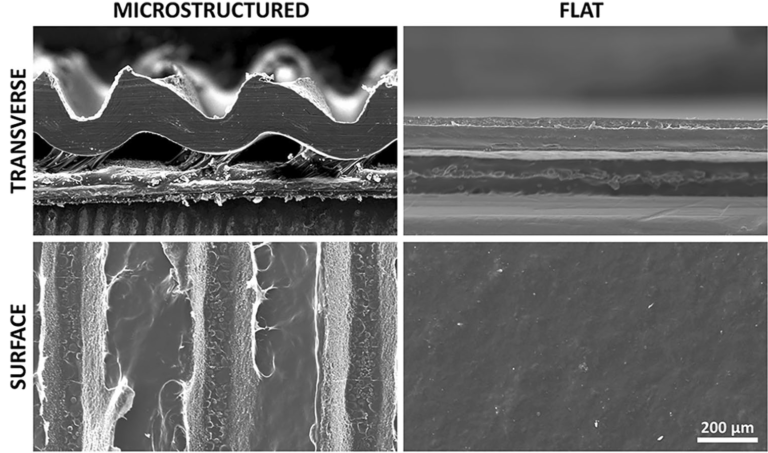
Nanostructured electrochemical sensor applied to the electrocoagulation of arsenite in WWTP effluent.
A sensitive electroanalytical method for the determination of arsenite, based on a heterostructure of aminated multiwalled carbon nanotubes and gold nanoparticles, was applied in an electrocoagulation (EC) treatment for the elimination of arsenite.
-
S. Piña, M. A. Sandoval, P. Jara-Ullo, D. Contreras, N. Hassan,
O. Coreño, R. Salazar - Chemosphere
- Volume 306, November 2022, 135530
- 10.1016/j.chemosphere.2022.135530
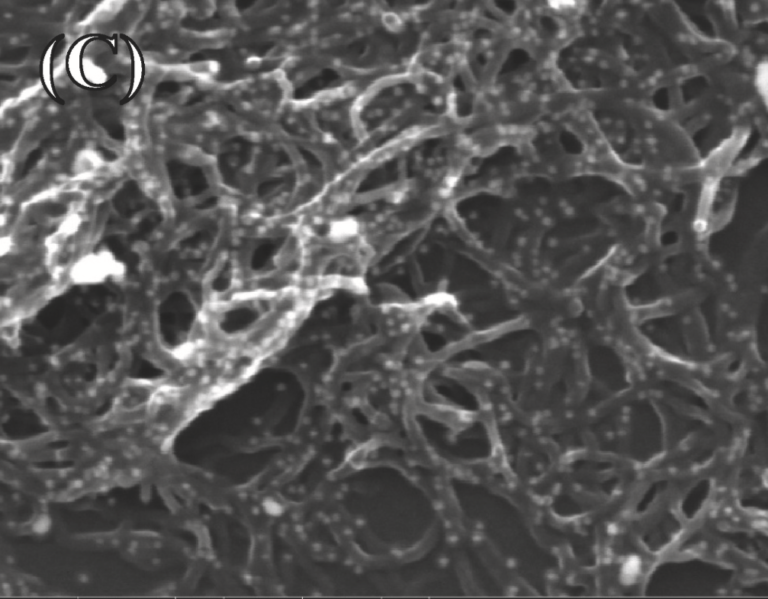
Expression of Hv1 proton channels in myeloid-derived suppressor cells (MDSC) and its potential role in T cell regulation.
The immunosuppression by MDSC is conditional to their ability to decrease the proton concentration elevated by the NOX2 activity, rendering Hv1 a potential drug target for cancer treatment.
- J. Alvear-Arias, C. Carrillo, J. P. Villar, R. Garcia-Betancourt, A. Peña-Pichicoi, A. Fernandez, M. Fernandez, E. M. Carmona, A. Pupo, A. Neely, O. Alvarez, J. Garate, H. Barajas-Martinez, H. P. Larsson, A. Lopez-Rodriguez, R. Latorre, C. Gonzalez
- PNAS
- Volume 19, April 2022, e2104453119
- 10.1073/pnas.2104453119
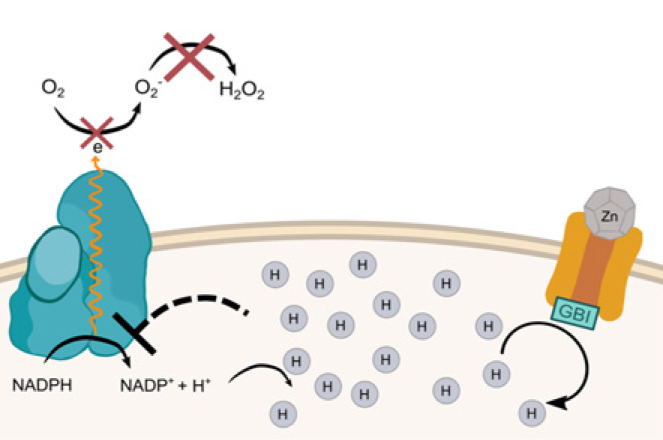
Spider Toxin SNX-482 Gating Modifier Spontaneously Partitions in the Membrane Guided by Electrostatic Interactions.
Spider toxin SNX-482 is a cysteine-rich peptide that interferes with calcium channel activity by binding to voltage-sensing domains of the CaV2.3 subtype.
- G. Mellado, N. Espinoza, J. Garate, A. Neely
- Membranes
- Volume 12, June 2022, 595
- 10.3390/membranes12060595
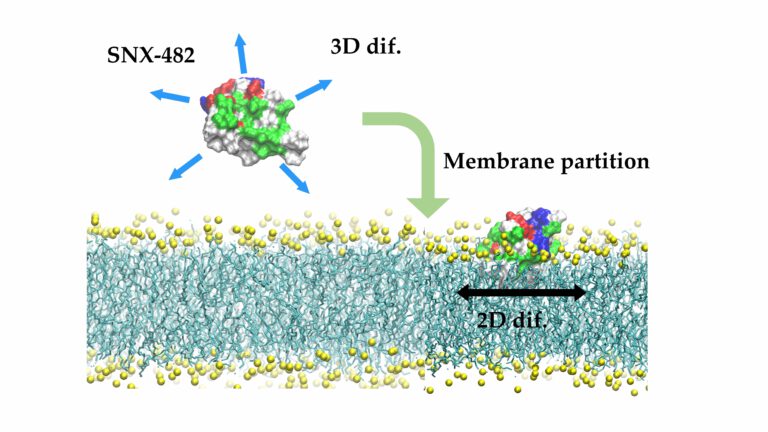
Mechanism of voltage sensing in Ca2+- and voltage-activated K+ (BK) channels.
In neurosecretion, allosteric communication between voltage sensors and Ca2+ binding in BK channels is crucially involved in damping excitatory stimuli. Nevertheless, the voltage-sensing mechanism of BK channels is still under debate.
- W. Carrasquel-Ursulaez, I. Segura, I. Díaz-Franulic, Valeria Márquez-Miranda, Felipe Echeverría, Y. Lorenzo-Ceballos, N. Espinoza, M. Rojas, J. A. Garate, E. Perozo, O. Alvarez, F. D. Gonzalez-Nilo, R. Latorre
- PNAS
- Volume 119, June 2022, e2204620119
- 10.1073/pnas.2204620119

On the effects of induced polarizability at the water–graphene interface via classical charge-on-spring models.
In this work, we have systematically studied, via molecular dynamics, two polarizable graphene models, denominated CCCP and CCCPD, employing the charge-on-spring model of the GROMOS forcefield, both being compatible with the polarizable water models COS/G2 and COS/D2, respectively
- Y. Escalona, N. Espinoza, M. Barria-Urenda, C. Oostenbrink, J. A. Garate
- Physical Chemistry Chemical Physics
- Volume 24, June 2022, 7748
- 10.1039/D1CP05573A
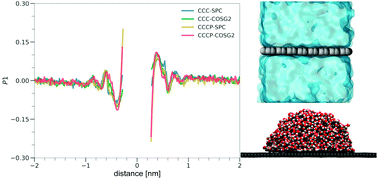
Optimization of N-PERT Solar Cell under Atacama Desert Solar Spectrum
In this work, we determined geometrical and doping parameters to optimize the power of an n-type bifacial passivated emitter and rear totally diffused solar cell (n-PERT).
- P. Ferrada, A. Marzo, M. Ruiz Ferrández, E. Ruiz Reina, B. Ivorra, J. Correa-Puerta, V. del Campo
- Nanomaterials
- Volume 12, October 2022, 3554
- 10.3390/nano12203554

Aquaporin Gating: A New Twist to Unravel Permeation through Water Channels.
The study of AQPs in their native membrane or overexpressed in heterologous systems have experimentally demonstrated that water membrane permeability can be reversibly modified in response to specific modulators.
- M. Ozu, . J. Alvear-Arias, M. Fernandez, A. Caviglia, A. Peña-Pichicoi, C. Carrillo, E. Carmona, A. Otero-Gonzalez, J. A. Garate, G. Amodeo, C. Gonzalez
- International Journal of Molecular Sciences
- Volume 23, October 2022, 12317
- 10.3390/ijms232012317

